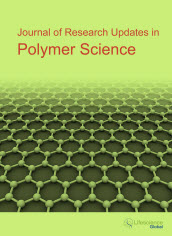jrups
Abstract : A Uniform Viscoelastic-Plastic Constitutive Model for MD-PMMA at a Wide Temperature Range
|
|
Abstract: The deformation characteristics of MD-PMMA vary greatly at different temperatures. In the paper, whether a uniform model could be used to describe these complex characteristics was discussed. Tensile properties of MD-PMMA at the temperatures of -50˚C, -25˚C, 20˚C, 60˚C, 90˚C were experimentally investigated. The entire deformation processes of PMMA were divided into four stages: elastic stage, viscoelastic stage, yielding stage and post-yielding stage. Strain softening and strain hardening phenomenon occurred in the yielding and post-yielding stage, it was the results of the competition between loading rate and plastic strain rate. A nonlinear model of activation dashpot was constructed, in the model, the evolution rate of plastic deformation was defined by Eyring’s theory, and the actual stress was the difference between external applied stress and internal resistance stress caused by plastic strain. The above activation dashpot serially connected with the standard linear model (SLM) to identify elastic and viscoelastic characteristics. A two iterations integral algorithm was proposed to simplify the inter-coupling between the internal stress and the plastic strain, and the unknown parameters in the model could be easily fitted by the experimental data. This uniform viscoelastic-plastic model was demonstrated that could predict different deformation behaviors at a wide temperature range. Keywords: Constitutive model, plastic strain, temperature, MD PMMA, internal stress.Download Full Article |
Abstract : Characterization of Silane Modified Polyvinyl Acetate Water Based Dispersion Film
|
|
Abstract: Major advantage of silane-modified systems is possibility to cross link reactive silanol groups and fortify polymer mechanical and chemical properties. However, application of modern analysis techniques and further characterization of macromolecular structure produced is complicated due to a poor solubility of silane modified polymer in various solvents. Silane modified polyvinyl acetate (PVAc) dispersions were produced by classic radical and RAFT polymerization using silane co-monomers and dispersion system stabilizer - silane modified industrial grade polyvinyl alcohol.The present paper deals with confirmation of silanol, siloxane bonds, silicon content and distribution, as well film surface morphology of silane modified PVAc dispersions films. Keywords: Polyvinyl acetate, RAFT, alkoxysilane, siloxane bonds, element mapping.Download Full Article |
Abstract : New Polymer Syntheses Part 59. Synthesis and Characterization of New Polyamides and Copolyamides Containing Thianthrene Moiety and Based on Methyl- and/or Tertiarybutyl-Cyclohexanone in the Main Chain
|
|
Abstract: Two new series of polyamides and copolyamides based on methyl-cyclohexanone and tertiary-butyl-cyclohexanone in the main chain were synthesized via the solution polymerization of 2,6-bis(m-aminobenzylidene)-methylcyclohex-anone VI, 2,6-bis(m-aminobenzylidene)tertiary-butyl-cyclohexanone VIII, and its copolyamides with p-phenylene diamines and m-phenylene diamines with diacid chlorides of thianthrene (2,7-Dichloroformylthianthrene-5,5`,10,10`-tetraoxide IV. These polyamides and copolymides ranged from yellow to orange color and had inherent viscosity up to 0.35-0.89 dL/g. All the polyamides and copolymides were insoluble in common organic solvents but dissolved completely in concentrated H2SO4. The thermal stabilities of the prepared polyamides were evaluated by TGA and DTG analyses. X– ray analysis showed these polymers having low degree of crystallinity in the region 2q = 5 – 60°. The morphological properties of some selected polyamides were detected by SEM. Keywords: Polyamides, Copolyamides, Thianthrene, Thermal Properties, arylidene polymers.Download Full Article |
Abstract : Synthesis and Characterization of Carbon Soot Particles Doped HPMC Polymer Composites
|
|
Abstract: Biodegradable Hydroxyl propyl Methyl cellulose based polymer composites of various concentrations were prepared by doping carbon particles of kerosene soot. These composites were synthesized by employing simple solution casting method, to study the physical properties of the same. The analytical studies like XRD, AC conductivity, Tensile strength, Acoustic impedance, AFM and FTIR spectroscopy were carried out to characterize these composites. From the results it is seen that, the amorphous carbon particle disturbs the semi crystalline nature of the polymer by getting interstitial into polymer network. Further, this results in the characteristic changes of other physical parameters like tensile strength and AC conductivity. We have made an attempt to establish a structure property relation of such changes in the physical properties with that of microstructural parameters derived from XRD. Keywords: HPMC, Carbon Soot, XRD, Crystallite Size.Download Full Article |






















